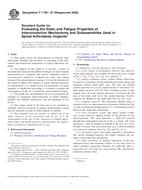We need your consent to use the individual data so that you can see information about your interests, among other things. Click "OK" to give your consent.
ASTM F1798-97(2008)
Standard Guide for Evaluating the Static and Fatigue Properties of Interconnection Mechanisms and Subassemblies Used in Spinal Arthrodesis Implants
STANDARD published on 1.12.2008
The information about the standard:
Designation standards: ASTM F1798-97(2008)
Note: WITHDRAWN
Publication date standards: 1.12.2008
SKU: NS-51603
The number of pages: 10
Approximate weight : 30 g (0.07 lbs)
Country: American technical standard
Category: Technical standards ASTM
Annotation of standard text ASTM F1798-97(2008) :
Keywords:
gripping capacity, interconnection, run out, spinal arthrodesis implant, subassembly, Arthrodesis implants, Fatigue--surgical implant materials, Gripping capacity, Interconnection mechanisms, Spinal implants, Static tests--orthopaedic materials/applications, Subassemblies, ICS Number Code 11.040.40 (Implants for surgery, prothetics and orthotics)
Additional information
| Significance and Use | ||||||
|
Spinal implants are generally composed of several components that, when connected together, form a spinal implant construct. Spinal implant constructs are designed to provide some stability to the spine while arthrodesis takes place. This guide outlines standardized evaluations of different interconnection mechanisms to facilitate comparison between different designs. Comparisons must be made cautiously and with careful analysis, taking into account the effects that design differences can have on the loading configurations. This guide is used to quantify the static and fatigue properties of different implant interconnection designs. The mechanical tests are conducted in vitro using simplified, unidirectional loads and moments. Fatigue testing in a simulated body fluid or saline may have a fretting, corrosive, or lubricating effect on the interconnection and thereby affect the relative performance of tested devices. Hence, the test environment, whether a simulated body fluid, saline (9g NaCl per 1000 mL H2O), with a saline drip, or dry, is an important characteristic of the test and must be reported accurately. The loading of spinal implant constructs in vivo will, in general, differ from the loading configurations used in this guide. The results obtained here cannot be used directly to predict in vivo performance. However, the results can be used to compare different component designs in terms of relative mechanical parameters. |
||||||
| 1. Scope | ||||||
|
1.1 This guide covers the measurement of uniaxial static and fatigue strength, and resistance to loosening of the component interconnection mechanisms of spinal arthrodesis implants. 1.2 The purpose of this guide is to provide a means of mechanically characterizing different designs of spinal implant interconnections. Ultimately, the various components and interconnections should be combined for static and fatigue testing of the spinal implant construct. It is not the intention of this guide to address the analysis of spinal implant constructs or subconstructs or to define levels of performance of spinal implants as insufficient knowledge is available to predict the consequences of the use of particular spinal implant designs. 1.3 This guide sets out definitions for use in measuring the strength of component interconnections of spinal implants, possible test methods themselves, and the reporting of test results. 1.4 The values stated in SI units are to be regarded as standard, with the exception of angular measurements, which may be reported in terms of either degrees or radians. 1.5 This standard does not purport to address all of the safety concerns, if any, associated with its use. It is the responsibility of the user of this standard to establish appropriate safety and health practices and determine the applicability of regulatory limitations prior to use. |
||||||
| 2. Referenced Documents | ||||||
|
We recommend:
Technical standards updating
Do you want to make sure you use only the valid technical standards?
We can offer you a solution which will provide you a monthly overview concerning the updating of standards which you use.
Would you like to know more? Look at this page.




 Cookies
Cookies
